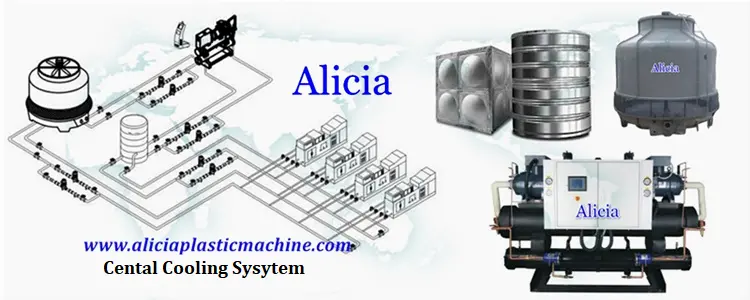Extruder central cooling water system

An extruder is a plastic molding equipment. Mainly used for various extruded plastic products, such as PE, PP, PVC, ABS, etc. The high temperature generated during the production process will cause difficulty in demoulding and slow molding, so the central cooling water system (pool, cooling tower, chiller) takes away the heat of the extruder. The chiller can provide circulating chilled water (5-30℃) for the extruder equipment, thereby shortening the cooling time of the extruder product and improving product productivity and quality.
After receiving the extruder chiller and connecting the water, you need to inject an appropriate amount of water into the chiller water tank. After the chiller works, the water in the water tank is cooled, and then the low-temperature cooling water is sent to the extruder through the water pump for cooling. After the heat is absorbed by the circulating water of the chiller, the temperature rises and then returns to the water tank. The water temperature of the chiller can be adjusted as needed (5-35℃). To a certain extent, the cooling effect is better than that of pools and cooling towers, and it saves water resources. Long-term use can save water. Therefore, the extruder chiller is an efficient and energy-saving cooling equipment.
So how to choose an extruder water cooler? First of all, whether the customer has an open cooling water tank, if so, the chiller should choose a closed shell and tube or plate exchange evaporator instead of a water tank coil evaporator. If you don't have an open tank or pool, choose a tank coil evaporator.
When selecting a chiller, we judge based on the hourly production capacity (glue volume) of the extruder, the hourly water usage of the tank, and the return water temperature. According to the law of conservation of energy, we can calculate the power of the chiller. In order to achieve the cooling effect, the chiller is usually slightly larger to avoid environmental factors affecting the energy efficiency ratio and ensure normal production.
Choice of two cooling methods for chillers. The customer's facility has a pool or cooling tower. Water-cooled chillers are more suitable than air-cooled chillers. The water-cooled chiller dissipates heat through the water tower, which has higher cooling stability and eliminates the need to purchase an additional cooling tower. If there is no cooling water tower and the cooling power is small, and the environmental ventilation effect is good, the air-cooling type can be selected. Of course, this is not absolute. Customers with a large budget can choose water cooling.

 differences between single shaft shredders and double shaft shredders
differences between single shaft shredders and double shaft shredders
 Difference of cross flow square tower & counter flow square tower
Difference of cross flow square tower & counter flow square tower
 What are the advantages of water-cooled chillers?
What are the advantages of water-cooled chillers?
 Masterbatch Frequently Asked Questions
Masterbatch Frequently Asked Questions